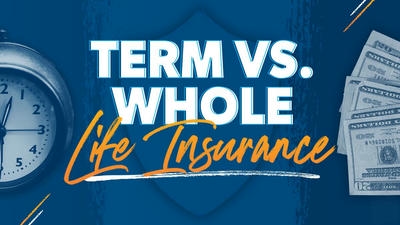
When it comes to securing your family’s financial future, life insurance is one of the most important purchases you can make. However, choosing the right type of life insurance can be a daunting task. Two of the most common types are term life insurance and whole life insurance. Each option has its unique features, benefits, and drawbacks. Understanding the differences between these two types of policies can help you make an informed decision that aligns with your financial goals and needs.
Understanding Life Insurance
What is Life Insurance?
Life insurance is a contract between an individual and an insurance provider. The individual pays regular premiums in exchange for a sum of money that will be paid to beneficiaries upon the individual's death. The primary purpose of life insurance is to provide financial security for loved ones in the event of the policyholder's untimely demise.
Why Do People Buy Life Insurance?
People buy life insurance for several reasons, including:
Financial Protection: To ensure that loved ones are financially secure after the policyholder’s death, covering expenses like mortgages, education, and daily living costs.
Peace of Mind: Knowing that there is a financial safety net for family members provides peace of mind for many individuals.
Debt Coverage: Life insurance can help cover debts that the policyholder may leave behind, relieving family members of the burden.
Term Life Insurance Explained

What is Term Life Insurance?
Term life insurance is a type of policy that provides coverage for a specific period, known as the "term." This term can range from one year to up to thirty years or longer. If the policyholder passes away during this period, the beneficiaries receive the death benefit. If the term expires and the policyholder is still alive, the coverage ends, and no payout is made.
Benefits of Term Life Insurance
Affordability: One of the most significant advantages of term life insurance is its affordability. Monthly premiums for term policies are generally lower than those for whole life insurance, making it accessible for individuals and families on a budget.
Simplicity: Term life insurance is straightforward and easy to understand. Individuals pay a fixed premium for a set period, providing clear coverage without complicated investment components.
Flexibility: Policyholders can choose the length of the term based on their specific needs. For instance, many people select terms that align with their mortgage payments or their children’s college education.
Convertible Options: Many term life policies offer conversion options that allow policyholders to convert their term policy into a whole life policy at a later date, typically without needing medical underwriting.
Focused Coverage: Term life insurance is ideal for individuals who want coverage primarily to protect their family during specific financial obligations, such as raising children or paying off a mortgage.
Whole Life Insurance Explained
What is Whole Life Insurance?
Whole life insurance provides lifelong coverage as long as premiums are paid. Unlike term insurance, whole life policies accumulate cash value over time in addition to providing a death benefit. The cash value can be borrowed against or withdrawn, providing additional financial flexibility.
Benefits of Whole Life Insurance
Lifelong Protection: Whole life insurance offers coverage for the entirety of the policyholder's life, ensuring that beneficiaries receive a death benefit no matter when the policyholder passes away.
Cash Value Accumulation: One of the unique features of whole life insurance is the cash value component, which accumulates over time. This cash value can serve as a savings vehicle, providing the opportunity for growth and financial security.
Stable Premiums: Whole life insurance premiums are fixed and do not increase as the policyholder ages or experiences health changes, making budgeting easier over time.
Dividends: Many whole life policies are eligible to receive dividends if the insurance company performs well. Policyholders can use these dividends to reduce premiums, purchase additional coverage, or accumulate cash value.
Financial Security: The permanence of whole life insurance provides a sense of financial security for policyholders, knowing that their beneficiaries will receive a payout without time limitations.
Key Differences Between Term and Whole Life Insurance

Coverage Duration
The most apparent difference between term and whole life insurance is the duration of coverage. Term life insurance provides coverage for a specific period, while whole life insurance offers lifelong protection.
Premium Costs
In terms of cost, term life insurance generally has lower monthly premiums compared to whole life insurance. This affordability allows many individuals to purchase higher coverage amounts for a lower cost, whereas whole life premiums are higher due to the lifelong coverage and cash value component.
Cash Value Component
Whole life insurance includes a cash value component, allowing policyholders to build savings over time. Term life insurance does not build cash value, and if the term expires, the policyholder receives no payout or accumulated savings.
Flexibility
Term life insurance is more flexible in terms of duration, allowing individuals to choose terms that meet their specific needs. Whole life insurance, while providing lifelong coverage, may be less flexible in terms of changing premiums and coverage amounts.
Making the Right Choice
Choosing between term life and whole life insurance depends on various factors, including financial goals, budget, needs, and preferences. Here are some considerations to help you make the right decision:
Assessing Financial Needs
Evaluate your financial situation and determine what kind of financial support your loved ones may need after your death. Consider factors such as outstanding debts, mortgage obligations, education costs for children, and daily living expenses.
Budget Considerations
Determine how much you can afford to spend on life insurance premiums each month. If you want a large coverage amount at a lower cost, term insurance may be a suitable option. However, if you prioritize lifelong coverage and savings, whole life insurance might be more appropriate despite the higher cost.
Long-Term Goals
Consider your long-term financial goals. If you seek a policy that provides coverage during specific financial obligations and want to budget for the short term, term life insurance may be suitable. On the other hand, if you want to build wealth and secure lifelong protection, whole life insurance could be the better choice.
Potential for Cash Value
If having a savings element in your life insurance policy is essential to you, consider opting for whole life insurance. The cash value can provide financial support during your lifetime, whether through loans, withdrawals, or as a source of funds for retirement.
Health Status
Your current health may also influence your decision. Individuals in good health may find it easier and cheaper to secure a permanent policy, while those with health concerns may benefit more from a temporary solution like term life insurance, especially if their health may change in the future.
The Role of Life Insurance in Financial Planning

Building a Comprehensive Financial Plan
Life insurance is just one piece of a broader financial plan. Individuals should assess their total financial picture, including investments, retirement savings, real estate, and emergency funds, to design a comprehensive strategy that meets their long-term goals.
Protecting Against Uncertainty
One of the key roles of life insurance is to provide a safety net during uncertain times. Unexpected events such as accidents, illnesses, or premature death can create financial hardships. Life insurance serves as a safeguard, ensuring that loved ones are protected even in challenging circumstances.
Incorporating Life Insurance with Other Financial Products
Many individuals opt to combine life insurance with other financial products like health insurance, disability insurance, and retirement accounts. This integrated approach allows for a more comprehensive safety net, providing multiple layers of protection against financial risks.
Revisiting Your Policy
Life circumstances can change over time, affecting your insurance needs. It is essential to revisit your life insurance policy regularly to ensure it continues to align with your financial goals. Significant life events such as marriage, the birth of a child, or career changes may necessitate adjustments to your coverage.
Conclusion
The decision between term life insurance and whole life insurance ultimately depends on individual circumstances, financial goals, and personal preferences. Term life insurance offers affordability and flexibility, making it an attractive option for those seeking coverage for a specific duration. On the other hand, whole life insurance provides lifelong protection and the added benefit of cash value accumulation, appealing to those looking for both security and savings.
Understanding the differences between these two types of life insurance is crucial in making an informed decision that aligns with your unique financial situation. By considering factors such as budget, financial needs, and long-term goals, you can select the policy that best fits your requirements. Remember, life insurance is an essential component of your overall financial plan and can provide peace of mind knowing that your loved ones are protected.
Related
-
Financial News

-
Cryptocurrency

-

-
Forex Market

-
Economic Indicators

-
Forex Market

